Noisy Bathroom Fan
Fix a Noisy Bathroom Fan
Easy fix for an annoying exhaust fan
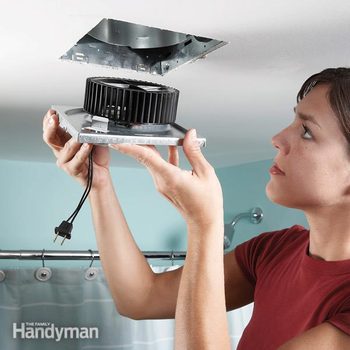 Family Handyman
Family Handyman
If the bath fan in your home is more than 20 years old, chances are it's pretty loud. A loud fan may be good for masking bathroom noise, but the jet engine roar is downright annoying the rest of the time. Worse yet, your old bath fan may not be moving enough air to keep your bathroom free of mold and mildew.
You might also like: TBD
Replacing a noisy bath fan
Newer-style bath fans, on the other hand, are so quiet you can hardly hear them running, and they cost very little to operate. It's easier than you think to swap out that noisy, inefficient bath fan, especially if you choose one that's designed to be installed without ripping out the bathroom ceiling.
Of the many replacement models to choose from, we picked the NuTone No. RN110 Ultra Pro Series because the fan can be installed from inside the bathroom. It's not the quietest model available, but at 0.6 sones (about 25 decibels), it's a huge improvement over the old 4-sone (about 60 decibels) fan we're replacing. If you can locate a joist, cut drywall and handle basic electrical work, you can do the whole job in about two hours and save about $200 on the installation. You'll need a stud finder, a drywall saw, a drill and screws, and aluminum duct tape.
Buy the right size for your bathroom
There's no such thing as a 'one-size-fits-all' bath fan. For bathrooms up to 100 sq. ft., calculate the required cubic feet per minute (cfm) by multiplying the room's length x width x height. Multiply that result by .13 and round up to the nearest 10. Example: 10 ft. wide x 9 ft. long x 9 ft. high x .13 = 105. Round up to 110 and buy a 110-cfm bath fan. For bathrooms larger than 100 sq. ft., simply add up the cfm requirements for each of these plumbing fixtures: toilet, 50 cfm; shower, 50 cfm; bathtub, 50 cfm; jetted tub, 100 cfm.
Turn off the power before proceeding
You'll have to remove the power cable from the old unit and connect it to the new fan. This must be done with the power off. Don't rely on turning off the fan switch; flip the breaker as well. Then double-check that the power is off with a voltage sniffer. If you're not comfortable working with electricity, hire an electrician to remove and connect the wires.
Find the joists and duct and enlarge the opening
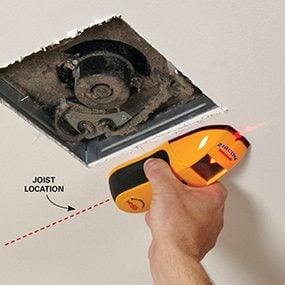
Photo 1: Find the joists
Slide a stud finder along the ceiling until you find the joist nearest the old fan. Mark the location. Then find the joist on the opposite side of the fan.

Photo 2: Mark and cut the ceiling opening
Using the template provided, trace the new opening onto the ceiling. Then cut along the lines using a drywall saw. Cut shallower strokes around the flexible duct so you don't puncture it.
Most bath fans are mounted to a ceiling joist with the duct running parallel to the joist. Start by locating the direction of your ceiling joists (Photo 1). Then locate the damper (you may have to remove the fan motor and blade from the housing). That'll tell you where the duct lies in the ceiling. Mark the duct location. Then enlarge the opening (Photo 2).
Remove and replace the housing, duct and fan
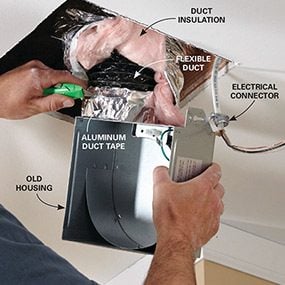
Photo 3: Disconnect and remove old parts
Unscrew the old fan housing from the joist. Then disconnect the electrical cable from the housing. Finally, slice through the duct sealing tape with a utility knife and disconnect the duct.
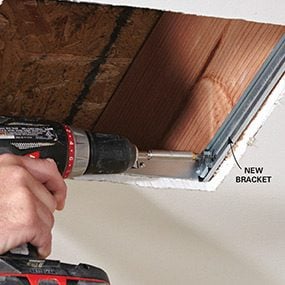
Photo 4: Mount the bracket
Slide the bracket through the opening and extend it so it contacts the joists on each side of the opening. Secure both sides to the joists with drywall screws.
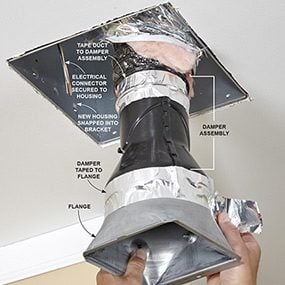
Photo 5: Connect the duct
Pull the old duct through the housing and into the room. Then tape the duct to the damper assembly. Slide the damper onto the flange and secure with aluminum duct tape. Push the duct, damper and flange back into the ceiling and secure the flange to the housing using the screw provided.
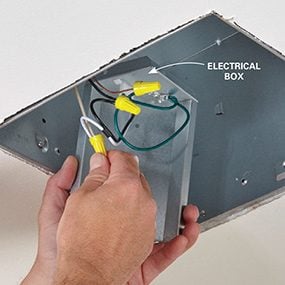
Photo 6: Connect the wires
Secure the hot (black), neutral (white) and ground (green/bare copper) wires with wire nuts. Then slide the metal electrical box into place in the housing and attach it with the screw provided.
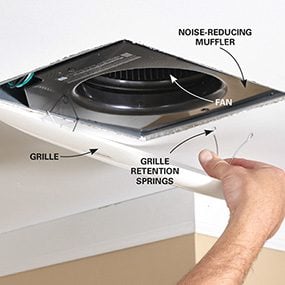
Photo 7: Install the fan and grille
Slide the fan assembly into the housing until it snaps in place. Secure with screws. Plug the electrical connector into the electrical box mounted earlier. Then screw in the noise-reducing muffler. Squeeze the grille springs and snap the grille into place.
With the opening now enlarged, you'll have room to disconnect the old duct, electrical cable and old housing (Photo 3). Install and secure the new mounting frame (Photo 4). Connect the electrical cable to the new housing and snap the housing into the frame so the duct opening is facing the existing duct. Then connect the duct, damper and flange using aluminum duct tape (Photo 5). Finish the rough-in by connecting the power wires and ground to the electrical box provided (Photo 6).
Then simply slide the fan into the housing and add the muffler and grille (Photo 7). Turn on the power and test. Apply a bead of fire-resistant (intumescent) caulk around the fan housing and drywall to prevent moisture intrusion into the attic.
Replacement procedure
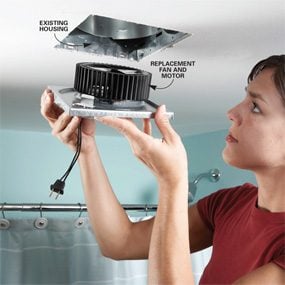
Installation
Install the new, quieter fan and motor assembly inside the existing fan housing.

Broan or Nautilus bathroom fan grille
Look at your fan's grille to determine the fan type. If it looks like this one, it's probably a Broan or a Nautilus.
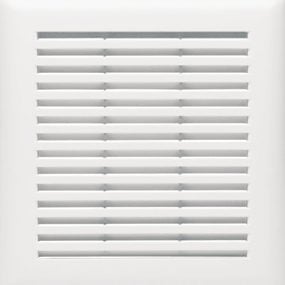
NuTone grille
If the grille looks like this one, it's most likely a NuTone.
A new kit from Broan and NuTone lets you cut fan noise almost in half (meaning the fan is barely audible). Installing the new fan and motor only takes about 10 minutes, with no rewiring or duct work required. The kit works on most Broan, NuTone and Nautilus bathroom fans—most bath fans are one of these brands. The Bath Fan Upgrade Kit is simply a quieter replacement fan that fits in the existing housing, so there's no need to rip up the ceiling, and the new grille gives your fan a new look.
The more powerful motor in this quieter fan means the fan will do a better job of ventilating the room. Buy the kit (No. 690) on Broan's Web site (broan.com) or at most home centers. Everything you need is contained in the kit, including the wrench.
If you have a grille other than the two shown here, the upgrade kit won't work on your fan.
Required Tools for this Project
Have the necessary tools for this DIY project lined up before you start—you'll save time and frustration.
Required Materials for this Project
Avoid last-minute shopping trips by having all your materials ready ahead of time. Here's a list.
Similar Projects
Source: https://www.familyhandyman.com/project/fix-a-noisy-bathroom-fan/







Tidak ada komentar:
Posting Komentar